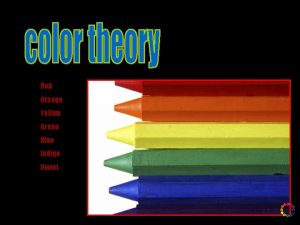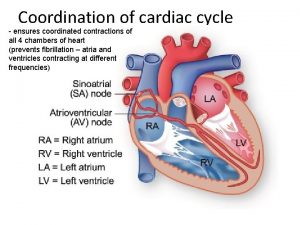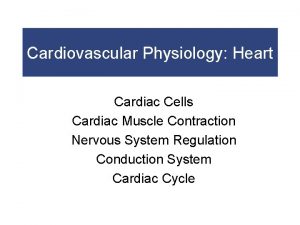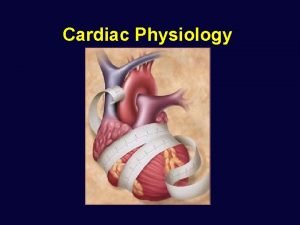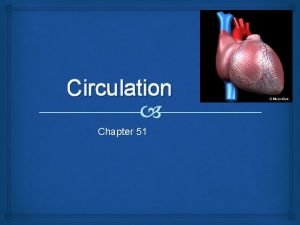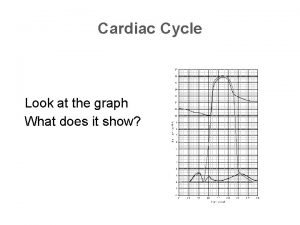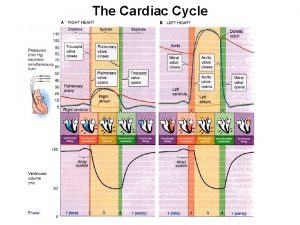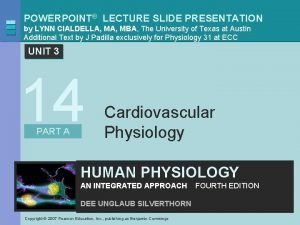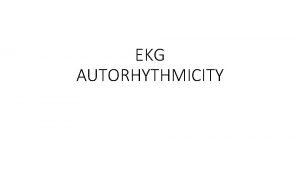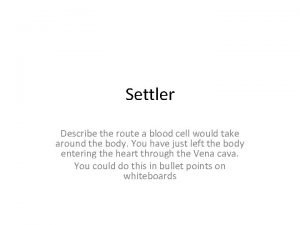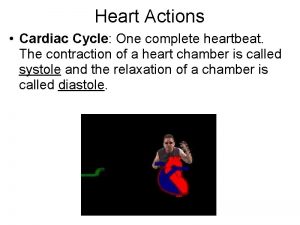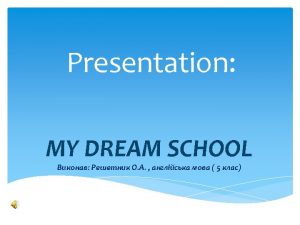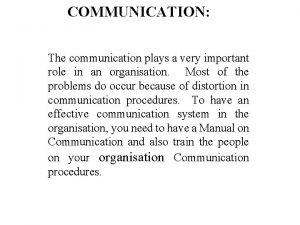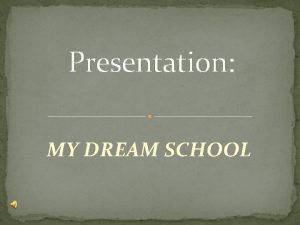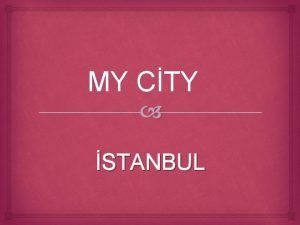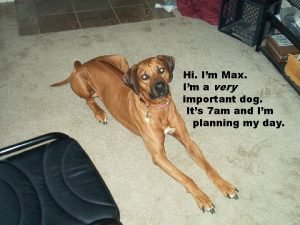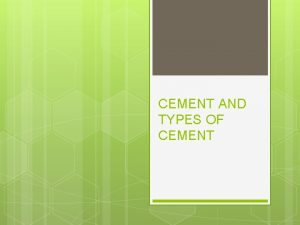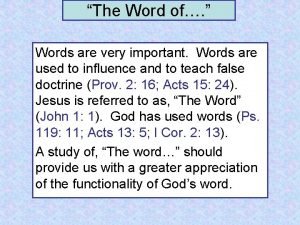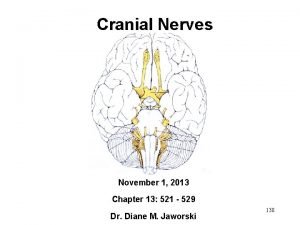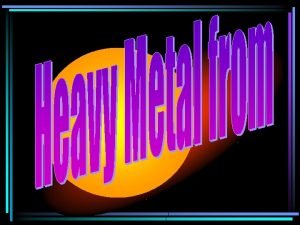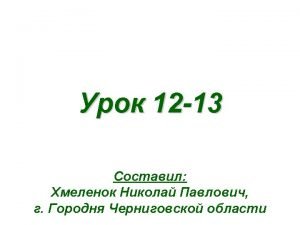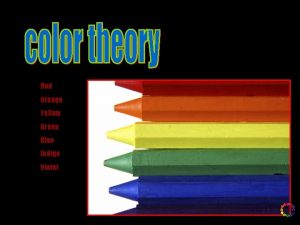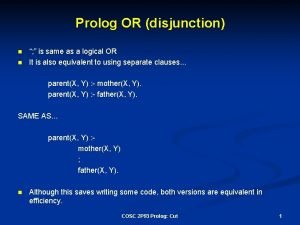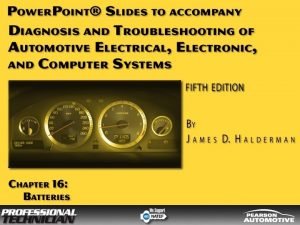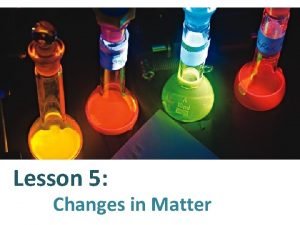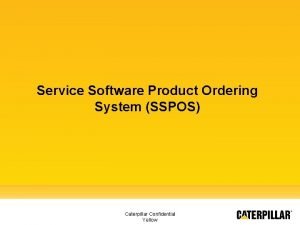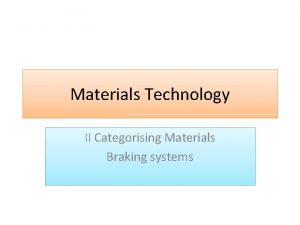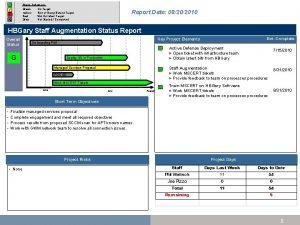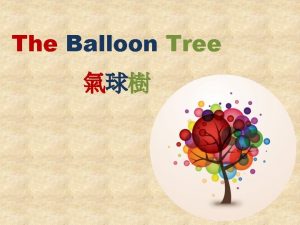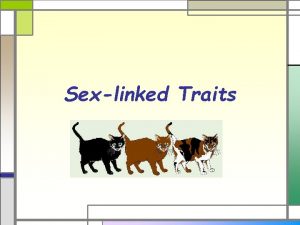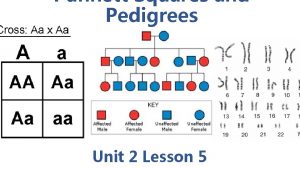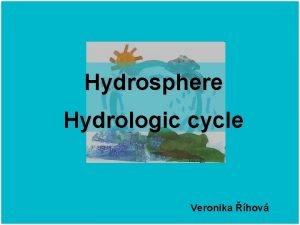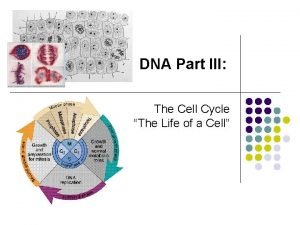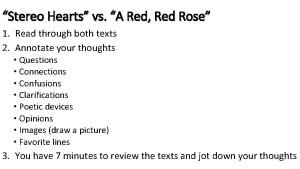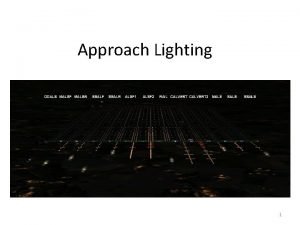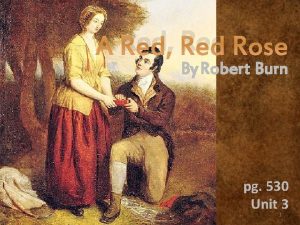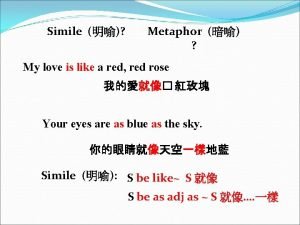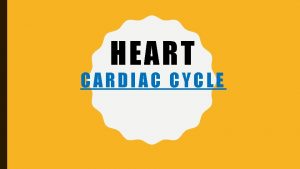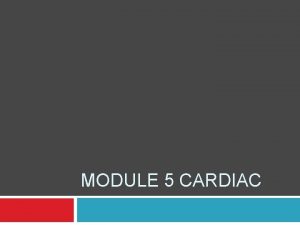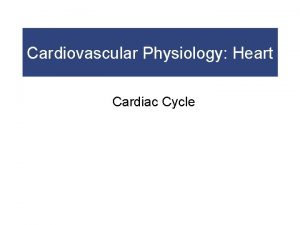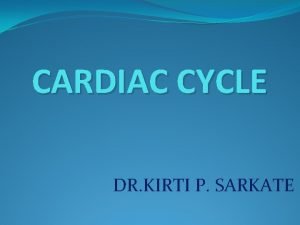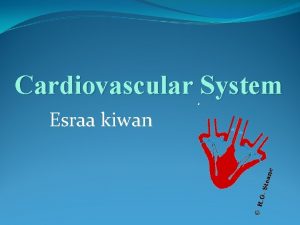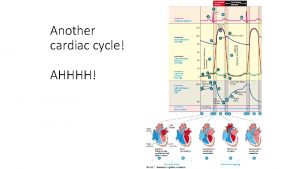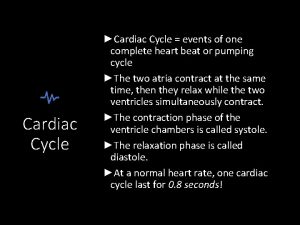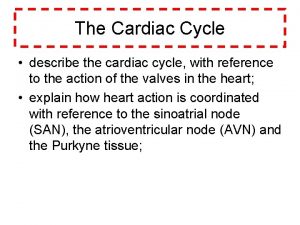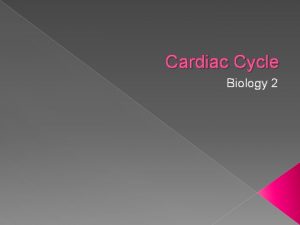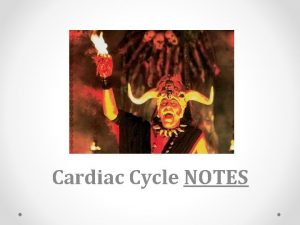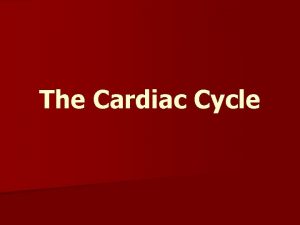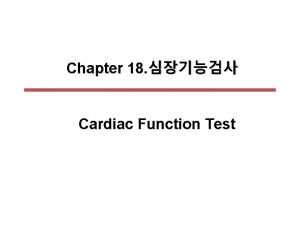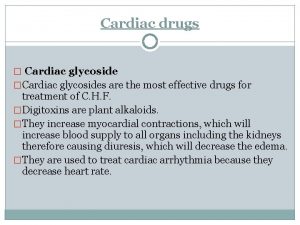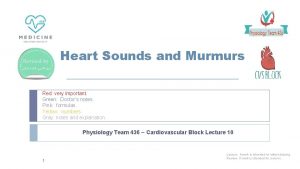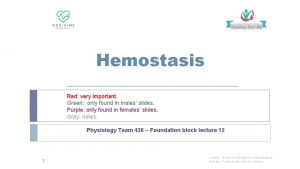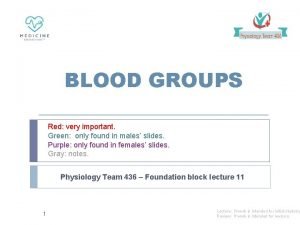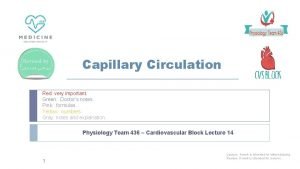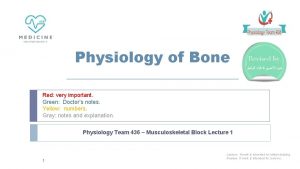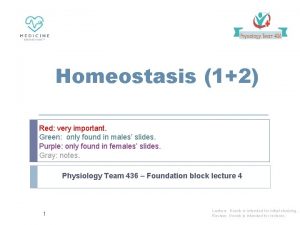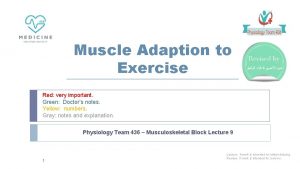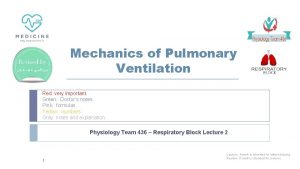Cardiac Cycle I II Red very important Green




























































- Slides: 60

Cardiac Cycle (I, II) Red: very important. Green: Doctor’s notes. Pink: formulas. Yellow: numbers. Gray: notes and explanation. Physiology Team 436 – Cardiovascular Block Lectures 3&4 1 Lecture: If work is intended for initial studying. Review: If work is intended for revision.

Objectives Study Smart: focus on mutual topics. We strongly recommend watching Dr. Najeeb’s explanation of the cardiac cycles! o o o Define cardiac cycle and state its duration at rest. State the function of the heart valves. Identify the phases of the cardiac cycle. Explain the relationship between the electrical and mechanical events during the cardiac cycle. Discuss left ventricular pressures and volumes changes during the normal cardiac cycle. Compare and contrast left and right ventricular pressures and volumes during the normal cardiac cycle. Define and state the normal values for the end-diastolic volume, end-systolic volume, stroke volume and ejection fraction. Describe the use of the pressure-volume loop in describing the phases of the cardiac cycle. Explain changes in aortic pressure during the normal cardiac cycle. Calculate pulse pressure and mean arterial pressure. Describe right atrial pressure changes during the cardiac cycle. Outline the venous pulse waves during the cardiac cycle. 2

Function of the Heart Intracardiac circulation � � The function of the heart is to pump blood. The heart is a double pump, consisting of pulmonary and systemic circulations that work together. 3

Valves of the Heart � There are 4 valves. Found at entry & exit of each ventricle. On the fibrous tissue ring separating the atria from the ventricles. � Each Ventricle has an entrance and an exit which are guarded by Cardiac Valves. � The valves allow blood flow in only one direction. � When the AV valves (Atrio-Ventricular valves which are the tricuspid and bicuspid) are open, Semilunar valves are closed and the opposite is true. (This is to prevent back-flow of blood from aorta or pulmonary artery to their perspective Ventricles). They open in pairs they NEVER open all together. � Opening and closure of the valves is based on the pressure gradient across the valves. � AV valve cusps are held by the Chorda Tendinea to Papillary muscles; this is to limit movements and eversions of the valves during ventricular systole. To hold it in place ( )ﻳﻌﻨﻲ ﻟﻤﻦ ﺗﺴﻜﺮ ﻣﺎ ﺗﻔﺘﺢ ﻣﻦ ﺟﻬﻪ ﺛﺎﻧﻴﻪ � While the papillary muscles are connected to the AV valves they DO NOT open or close them. 4 Ventricular diastole: AV valves are opened, Semilunar are closed Ventricular systole: AV valves are closed, Semilunar valves are opened Papillary muscles have no role in opening or closing the valves

Valves of The Heart In this picture we see the left AV valve open to allow blood to move and fill the left ventricle. And like we said before the semilunar valve (aortic valve here) will be closed to prevent backflow of blood from the aorta. 5 In this picture we see the opposite, the left AV valve is closed and the Semilunar valve is open.

The Cardiac Cycle; The Heart Beat • It is a sequence of events that take place in the heart in each beat • The cardiac cycle (heart beat) consists of alternate periods of systole (contraction and emptying) and diastole (relaxation and filling). • When the heart rate is 72 Beat/min the duration of the cardiac cycle is 0. 8 sec. The duration is shortened with increase in HR (Heart Rate). • The atria and ventricles go through separate cycles of systole and diastole. • Contraction happens with excitation, whereas relaxation follows the subsequent repolarization. • Ventricle contraction generate pressure which is responsible for orderly blood movement. • The Ventricles are flow and pressure generators. • Blood flows from an area of high pressure to an area of low pressure. • The actual pump is the ventricles. 6

Events During the Cardiac Cycle Events are the same in the right & left sides of the heart, but with lower pressures in the right side. There are 5 events that occur during the cardiac cycle: (Electrical events are followed by mechanical events) 1. Electrical events (ECG). 2. Mechanical Events (mechanical phases of cardiac cycle). 3. Pressure changes. 4. Volume changes. 5. Heart sounds. (only present upon CLOSURE of valves! Opening of valves produces no sounds!) 7 2

Cont. Electrical event Excitation and ECG changes Contraction followed by relaxation Ventricular pressure changes Ventricular volume changes Valve closure Heart sound ﻳﻈﻬﺮ valve ﻋﻨﺪﻣﺎ ﺗﻐﻠﻖ ﺻﻮﺕ ﺍﻟﻘﻠﺐ Valve opening 8 Mechanical event Aortic Pressure changes Right atrial pressure changes Jugular venous waveforms change in ﻳﻤﻜﻨﻨﺎ ﻧﻜﺸﻒ pressure right atrium from right atrium

Review of Ventricular Volumes Enddiastole volume (EDV) • is the volume of blood in each ventricle at end of diastole. • It is about 110 -130 ml. Endsystolic volume(E SV) • is the volume of blood left in each ventricle at end of systole. • It is about 40 -60 ml. Stroke volume (SV) • • • Is volume of blood that pumped by each ventricle per beat. Amount of blood ejected from ventricles during systole. It is equal to the difference between the EDV and ESV. (Stroke Volume (SV) = EDV – ESV (ml)) ↑ contraction force results in an ↑ SV (example: during exercise) • It is about 70 ml. Ejection fraction (EF) Diastolic filling volume(D FV) 9 • • • EF is the proportion of EDV pumped in a one heartbeat. (Ejection Fraction (EF) = (SV/EDV) * 100)) ﻋﺒﺎﺭﺓ ﻋﻦ ﻧﺴﺒﺔ ﺍﻟﺪﻡ ﺍﻟﻠﻲ ﻃﻠﻊ ﻣﻦ ﺍﻟﻘﻠﺐ ﻓﻲ ﺍﻟﻨﺒﻀﺔ ﺍﻟﻮﺍﺣﺪﺓ EF Fraction of end-diastolic volume that is ejected. Example: in patient with heart failure EF will EF can be a diagnostic indicator of heart function. be less than 65% because the heart fail to 60 -65 %. pump SV. • Is the volume of blood which flows from the atrium into ventricle during diastole. • It is equal to the difference between the EDV and ESV. • It is about 70 ml. EDV • Maximum ESV • Minimum

Mechanical Events (Phases) During the Cardiac Cycle q • • q q • • • q • • Each cardiac cycle (heartbeat) consists of 2 major periods (phases): Systole (contraction) and Diastole (relaxation). repeated in (Relaxation) next beat (Contraction). The atria and ventricles go through separate cycle of Systole and Diastole. Normally, diastole is longer than systole, systole is shorter but strong. Tissues receive blood during systole and diastole Starling law of the heart states that contractility depends on the initial length of the muscle fiber. ﻣﺜﻞ ﺍﻟﻨﺒﻴﻄﺔ ﻟﻤﻦ ﻧﺸﺪﻫﺎ ﻭ ﻧﻀﺮﺏ Ventricular systole= 0. 3 sec Ventricular diastole= 0. 5 sec Atrial systole= 0. 1 sec Atrial diastole = 0. 7 sec Cardiac cycle is 0. 8 Sec 0. 3 + 0. 5 = 0. 8 Sec Cardiac cycle is 0. 8 Sec 0. 1 + 0. 7 = 0. 8 Sec Importance of the long ventricular diastole? Coronary blood flow Ventricular filling 10 Coronary blood flow: • In Systole, coronary arteries get squeezed so there’s limited supply of blood to the heart • In Diastole, heart relaxes oxygenated blood can pass through coronary arteries

Mechanical Events (phases) During The Cardiac Cycle Mechanic al event Made ridiculously simple Video of (Cardiac Cycle) Duration: (3: 16 mins) Ventricular diastole Ventricular systole Isometric relaxation phase Rapid filling phase Reduced (slow)fillin g phase Atrial systole Isometric contractio n phase Rapid ejection phase Early ventricular diastole Mid ventricular diastole Late ventricular diastole 4 5 7 8 1 2 3 Protodiastole* 11 *Protodiastole: the first of four phases of ventricular diastole Reduced(slow)ej ection phase 6 ﺍﺣﻔﻈﻮﺍ ﺍﻟﻤﺮﺍﺣﻞ ﺑﺎﻟﺘﺮﺗﻴﺐ ﺍﻟﺮﻗﻤﻲ ﺃﻔﻀﻞ It is a cycle, it can be started at any phase

(Phase 2): Reduced Filling Phase (diastasis); Mid Diastole (Phase 1): Rapid Filling Phase; Early Diastole • • • The SA node did not reach threshold which means it did not get the AP yet The atrium is still also in diastole. The continuous inflow of blood results in increased pressure at the atrium which exceeds the pressure of the ventricles (0 atm) opening the mitral cusp (bicuspid) Atrial pressure > ventricular pressure. This pressure differential, the AV valve is open, and blood flows directly from the atrium into the ventricle. 60 -70 % of the blood passes Passively to the ventricles along pressure gradient resulting in: Ø Increase in ventricular volume rapidly Ø Increase in Ventricular pressure (because of filling) Ø Decrease in Atrial pressure (Because of emptying) • 3 rd heart sound is heard 12 • AV valves are still open • The remaining atrial blood flows slowly into the ventricles. • LV volume ↑ (slowly. ) • LV pressure gradually ↑(Because of filling) In both phases: • TP interval is seen on the ECG (the interval after ventricular repolarization and before another atrial depolarization) • Aortic pressure is still decreasing Atria Ventricles AV Valves Semilunar Valves ECG Diastole Opened Closed T-P interval

(Phase 3): Atrial Systole; Late Ventricular Diastole • Preceded by atrial depolarization. • The SA node reaches threshold and fires • Atrial contraction (-At end of ventricular diastole- systole duration 0. 1) → rise in atrial pressure which is see as a wave (will be explained later) • The atrial pressure exceeds the ventricle pressure means AV valve remains open and semilunar is closed. • More blood is squeezed into the ventricle • Tops off last 27 -30% of ventricular filling ≈ 40 ml → rise in ventricular pressure. • Here it reaches EDV=average 135 ml. • In this phase blood cannot enter the atria which result in back flow to the jugular vein (which make us see the pulse) Major Changes In Phase 3 Atria Systole • A 4 th heart sound is heard here. Ventricle Diastole • Aortic pressure is still ↓. AV Valves Opened • At ECG we see it as P wave. Closed • At the end of this phase EDV is achieved (110 -130 m. L) Ventricular diastole is finished here Semilunar Valves ECG P wave • In this phase aortic pressure reaches its minimum value which is 80 atm 13

Effect of Atrial Contraction on Ventricle Filling At Rest Atrial contraction adds little extra blood to the ventricles. At rest, atrial systole is not important (only important during exercise) During Exercise When the heart rate is high, ventricle filling time is reduced. (during exercise) During exercise, atrial contraction adds a substantial amount of blood to the ventricles. (Extra volume adds up) EDV ESV 14 ﺍﻟﻠﻲ ﻻﺯﻡ ﺗﻌﺮﻓﻪ ﺍﻧﻪ ﻓﻲ ﺣﺎﻟﺔ ﺍﻟﺮﺍﺣﺔ ﻣﺎ ﻧﺤﺘﺎﺝ ﺩﻡ ﻳﻨﻀﺦ ﺑﻜﺜﺮﺓ ﺑﺲ ﻓﻲ ﺍﻟﺘﻤﺮﻳﻦ ﻧﺤﺘﺎﺝ ﺩﻡ ﺍﻛﺜﺮ ﻷﻨﻪ ﻧﺒﻐﻰ ﺍﻛﺴﺠﻴﻦ ﺍﻛﺜﺮ

(Phase 4): Isovolumetric Ventricular Contraction � The impulse passes through the AV node and specialized conduction system to excite the ventricles → ventricular depolarization → QRS complex in the ECG o At the beginning of ventricular systole period between closure of AV- vs. & opening of Semilunar- vs. Preceded by ventricular depolarization. Starts with closure of AV- vs. o This is followed by ventricular contraction → ventricular pressure immediately exceeds atrial pressure → The AV valve is closed → 1 st heart sound is heard. o The aortic valve is still closed. o Ventricular pressure must continue to increase before it exceeds aortic pressure to open the aortic valve. o Because no blood enters or leaves the ventricle, the ventricular chamber remains at constant volume, and the muscle fibres remain at constant length. o This period lasts about 0. 04 - 0. 05 s, until the pressures in the left ventricle exceeds the pressures in the aorta (80 mm Hg) and the aortic valve opens. o During isovolumetric contraction, the AV valves bulge into the atria, causing a small but sharp rise in atrial pressure → c wave in the atrial pressure curve (will be explained later) Aortic pressure is still ↓. o � Ventricular pressure ↑. 15

For the previous slide: For the next slide: Major Changes In Phase 4 • Left ventricle is highest in pressure at this phase (P=120) • Left ventricle lowest during diastole ( P=0) Ø Generally LV pressure is 120/0 Atria Diastole Ventricle Systole AV Valves Closed Semilunar Valves At beginning: closed (aortic) End: opened ECG QRS complex Pressure of aorta is lowest at the end of this phase ( P= 80 ) opening of aortic valve The closure of AV valves at the beginning of this phase is heard as the sound “lob” • • • 16 Ventricle is a closed chamber. Volume in ventricle = EDV Ventricle contracts with no changes in volume. • Aortic valve is highest 120 at this phase ( blood keeps on pouring after aortic valve opens) • Aortic valve is minimum 80 when aortic valve opens (end of isovolumetric contraction) Ø Generally aortic pressure is 120/80 IN THIS PHASE BLOOD GOING FROM LV TO AORTA > THAN BLOOD LEAVING AORTA TO TISSUES ( aortic pressure is highest)

(Phase 5): Rapid (maximum) Ejection Phase o Contraction of the ventricle → ↑ intraventricular pressure. When ventricular pressure exceeds aortic pressure, i. e. , at ≈ 80 mm. Hg → the aortic valve is forced open → ejection of blood begins. Semilunar valve is open o Ejection is rapid during this phase, then slowing down as systole progresses during the slow ejection phase (next phase ). o Ventricular volume decreases substantially as blood is rapidly pumped out. o The ejected volume is the SV. ≈ 75% of SV is ejected during this phase. o the remaining volume is the ESV (averages about 65 ml). o Blood is forced into the aorta faster than blood is draining off into the smaller vessels at the other end → ↑ of aortic pressure. o Peak pressures in the left ventricle is about 120 mm Hg. Late in systole, pressure in the aorta actually exceeds that in the left ventricle, but for a short period momentum ( ﻳﻮﻗﻒ ﺑﺸﻮﻱ ﺷﻮﻱ ، ) ﺍﻟﺸﺨﺺ ﺍﺫﺍ ﻗﺮﺭ ﻳﻮﻗﻒ ﻭﻫﻮ ﻳﺮﻛﺾ keeps the blood moving forward. o The atria are in diastole. The AV valves are pulled down by the contractions of the ventricular muscle, and atrial pressure drops → x decent in the atrial pressure curve. (explained later) 17

(Phase 6): Slow (Reduced) Ejection Phase • Volume of left ventricle is decreased pressure is decreased • IN THIS PHASE BLOOD GOING FROM LV TO AORTA < THAN BLOOD LEAVING AORTA TO TISSUES o This is the last phase of ventricular systole, atria are in diastole o Ejection is slow → ventricular volume ↓ more slowly. o ≈ 25% of SV is ejected during this phase. Almost 25% of ventricular blood o The intraventricular pressure declines somewhat before ventricular systole ends. (aortic pressure decreases) o Aortic valve closes at the end of this phase, as a result of: • • - ↓ Ventricular pressure < aortic pressure o When LV pressure 110 mm. Hg (Aortic back pressure& Aortic-v closes) o The atria are in diastole. 18 • • • At the end of this phase aortic valve closes The closure of aortic and pulmonary valves produces second heart sound and is heard as ”dub” The time between lub and dub is a systole. 3 rd and 4 th sound during diastole. The blood ejected in both rapid and reduced ejection phase is the stroke volume.

(Phase 7): Protodiastolic Phase Female doctor does not consider this phase in the cardiac cycle. o The T wave on the ECG signifies ventricular repolarization occurring at the end of ventricular systole. o The already falling ventricular pressures drop more rapidly. This is the period of protodiastole, which lasts for a very short period of time; ≈ 0. 04 s. ( ) ﺑﻌﺾ ﺍﻟﻜﺘﺐ ﺗﻌﺘﺮﻑ ﺑﻌﻬﺎ ﻭﺍﻟﺒﻌﺾ ﻻ o Physiologists have different opinion about the existence of this phase. Physiologists believe in its existence think that the aortic valve has not yet closed by the end of the slow ejection phase and that the protodiatolic phase is the period between the end of ventricular systole and closure of the aortic valve. o Thus, protodiastole ends when the momentum of the ejected blood is overcome and the aortic valve closes, setting up transient vibrations in the blood and blood vessel walls o → second heart sound (S 2). o After the valves are closed, pressure continues to drop rapidly during the period of isovolumetric ventricular relaxation, which follows. o The atria are still in diastole. The atrial pressure continues to rise due to continuous venous return. However, atrial pressure is still lower than the ventricular pressure. Some physiologists believe that at the end of the systole (reduced ejection phase) aortic valve is still not closed They believe that the LV has stopped contraction but blood is still moving due to momentum. They believe aortic valve closes in protodiastolic phase ﻣﺎ ﻳﺘﺴﻜﺮ. ﻫﺬﺍ ﺍﻟﻤﻮﻣﻨﺘﻢ ﺑﺎﻟﻀﺒﻂ ﻭﺍﻟﺪﻡ ﻳﺼﻴﺮﻟﻪ ﻧﻔﺲ ﺍﻟﺸﻲ. ﺍﻟﻲ ﺑﻴﺼﻴﺮ ﻫﻮ ﺍﻧﻚ ﺑﺘﻤﺸﻲ ﺷﻮﻱ ﺯﻳﺎﺩﺓ ﻭﺗﺘﺒﺎﻃﺄ ﺳﺮﻋﺘﻚ ﻟﻴﻦ ﻣﺎ ﺗﻘﺪﺭ ﺗﻮﻗﻒ. ﻣﻨﺖ ﻗﺎﺩﺭ ، ﺗﺨﻴﻞ ﻧﻔﺴﻚ ﺗﺮﻛﺾ ﻭﺗﺒﻲ ﺗﻮﻗﻒ ﻓﺠﺄﺔ : ﻣﻮﻣﻨﺘﻢ ﺍﻻﻭﺭﺗﻚ ڤﺎﻟڤ ﺍﻻ ﻟﻤﺎ ﻧﺘﻐﻠﺐ ﻋﻠﻰ ﺍﻟﻤﻮﻣﻨﺘﻢ 19

(Phase 8): Isovolumetric Ventricular Relaxation In beginning of diastole when the aortic valve closes, the AV valve is not yet open, because the ventricular pressure still exceeds atrial pressure, so all valves are once again closed for a brief period of time and no blood can enter or leave the ventricle. Preceded by ventricular repolarization. Period between closure of semilunar-vs& opening of AV-vs. • The muscle fibre length and chamber volume remain constant. • As the ventricle continues to relax → the pressure steadily falls. • The atria are still in diastole. The atrial pressure continues to rise due to continuous venous return → v wave in the atrial pressure curve. However, atrial pressure is still lower than the ventricular pressure. • The mitral valve opens at the end of this phase. • This phase thus represents the beginning of diastole and it’s the quiescent period between closure of the aortic valve and opening of the mitral valve. • It lasts for ≈ 0. 04 sec. 20 • • • LV is a closed chamber, i. e. relax with no changes in volume. Volume of blood in ventricle = ESV. AV- vs open at the end of this phase. Major Changes In Phase 8 Atria Diastole Ventricle Diastole AV Valves Beginning: Closed End: opened Semilunar Valves (aortic) closed • Isovolumetric relaxation Ventricles relax without changing volume to reduce Pressure in LV Isovolumetric contraction ventricles contract without changing volume to increase pressure in LV • Ventricles relax pressure decrease atria is filling with blood pressure increases Pressure of atria more than LV mitral valve opens • Rapid filling phase (repeat cycle) In males’ slides 2 nd heart sound is heard in protodiastolic phase In females’ slides 2 nd heart sound is heard in Isovolumetric relaxation phase

Ventricular Filling v While the left atrium in diastole, the blood continues to flow from the pulmonary veins into the left atrium and therefore, atrial pressure rises continuously. v When the ventricular pressure falls below the atrial pressure (as at the end of Isovolumetric Ventricular Relaxation), the AV valve opens, and ventricular filling occurs once again. v When the AV valve opens, and ventricular filling occurs once again, the atrial pressure drops. (y descent in the atrial pressure curve. ) v Normal LV pressure during the cardiac cycle ≈ 120/3 -12 (120/0) mm. Hg Mitral valve closes S 1 (isovolumertic contraction) aortic valve opens end of isovolumetric contraction Peak of graph “Rapid ejection phase” where aortic and LV pressure are highest) aortic valve closes end of reduced ejection phase or protodiastole mitral valve opens rapid filling phase 1 closure mitral valve lub 2 closure of aortic dub Between lub and dub (systole) Between dub and lub (diastole) LV = left Ventricle Note: LV pressure during cardiac cycle is LV systole / LV diastole 21

ONLY IN MALES’ SLIDES LV Pressure-Volume Relationship During The Cardiac Cycle: LV pressure–volume cycle ‘loop’ (It is a combined graph of volume and pressure, as x-axis represent volume and y-axis represent pressure) This slight increase in pressure is caused by ‘atrial systole’ Heart Sound 22 Phase 3 rd Rapid filling phase 4 th Atrial systole 1 st Isovolumetric contraction 2 nd Reduced ejection phase

ONLY IN MALES’ SLIDES Basic Myocardial Mechanics (brief description of the cardiac cycle phases) o Ventricular systole and diastole can be divided into early and late phases. o Systole: 1) Early systole = ‘Isovolumetric Contraction’ 2) Late systole = ‘Isotonic Contraction’ = ‘Ejection Phase’ (rapid and reduced) o Diastole: 1) Early diastole = ‘Isovolumetric Relaxation’ 2) Late diastole = ‘Isotonic Relaxation’ = ‘Filling Phase’ (rapid and reduced) Some physiologists prefer this classification of cardiac cycle (not the 8 phases) 23

ONLY IN MALES’ SLIDES Ventricle Systole and Diastole (will be discussed later) o Ventricle systole: o Ø It is measured by ‘Contractility’. Ø Affected by: 1. Function of the muscle 2. Initial volume (Preload)’before systole’ 3. Initial pressure (Afterload)‘the pressure when ventricle begins contraction’ Ventricle diastole: Ø It is measured by ‘Compliance’: C = ΔV / ΔP Ø Affected by: 1. Connective tissue 2. Venous pressure 3. Venous resistance Aortic Pressure in Systole and Diastole Aortic pressure: Systolic (systole of LV) = 120 mm. Hg Diastolic (diastole of LV) 80 mm. Hg Yellow part represents Ejection in systole 24 Isovolumetric contraction phase (aortic pressure decreasing)

Recorded pressure changes & Ventricular Volume Changes • Ventricular pressure changes 120/3 -12 mm. Hg Aortic pressure Arterial pressure waves Pulmonary artery pressure Atrial pressure Jugular venous pressure • • Ventricular Pressure 25 In general we are going to record the pressure changes in the ventricles , arteries and veins. Then we will have the ventricular pressure , aortic pressure , pulmonary pressure and the atrial pressure in which the atrium is a continuation with the jugular vein because there is no valve between them so that is why the atrial pressure is the venous pressure.

Changes in Aortic Pressure Ascending or anacrotic limb Descending or catacrotic limb � This coincides with the ‘rapid ejection phase’. � � The amount of blood that enters aorta > the amount that leaves � � 26 Aortic pressure ↑ up to 120 mm. Hg Passes in 4 stages (next slide) This coincides with the ‘reduced The pressure in ejection the aorta willphase’. decrease until 110 mm. Hg (because the blood is going to the systemic ) at this point the aortic valve will close forming a notch which is because of the elastic reoil of the aorta and then it will again decrease till it reach 80 again.

Stages of the Descending (Catacrotic) Limb In Aortic Pressure 1 • ↓Aortic pressure This coincides with the ‘reduced ejection phase’ The amount of blood enters aorta < leaves • 2 Dicrotic notch (incisura): Due to closure of aortic valve • There is sudden drop in aortic pressure. • This notch is seen in the aortic pressure curve at end of ventricular systole. 3 Dicrotic wave Due to elastic recoil of the aorta • Slight ↑ in aortic pressure 4 Slow ↓ aortic press 27 Why did the pressure increase in Dicrotic notch? Aorta is an elastic artery ( has elastic fibers on its wall) Those fibers allow aorta to expand during ventricular systole to accommodate stroke volume. When diastole starts, aorta recoils( )ﻳﻨﻜﻤﺶ ﺑﻌﺪ ﻣﺎ ﺗﻮﺳﻊ ﻓﻲ ﺍﻟﺴﺎﻳﺴﺘﻮﻟﻲ increases pressure Up to 80 mm. Hg Due to continuous blood flow from aorta →systemic circulation

Cont. 28

Pulse Pressure � Maximum aortic pressure = Systolic pressure (SP)= 120 mm. Hg � Minimum aortic pressure = Diastolic pressure (DP)= 80 mm. Hg Pulse pressure (PP)= SP – DP= 120 – 80= 40 mm. Hg � � An increase in pulse pressure can indicate a hardening of the arteries. (arteries are pressure reservoirs). P P Hardening of aorta increase in pulse pressure due to increases in systolic aortic pressure +120 and decrease in diastolic aortic pressure less than 80 In systole blood will flow from LV to aorta, aorta won’t be able to expand increased systolic pressure In Diastole aorta wont be able to recoil increase in diastolic pressure 29 SP= systolic pressure DP = diastolic pressure PP = pulse pressure

Mean Arterial Pressure (MAP) Pressure of aorta and systemic arteries in cardiac cycle (during LV systole and diastole) (MAP) does not equal (SP + DP) / 2 Aortic pressure is closer to the minimum value for longer than it is close to the maximum value. (because the time that atrial pressure spend in the minimum pressure more than in high pressure) MAP is the driving force for blood flow. 30 �Calculations: Mean Arterial Pressure (MAP) = 1/3 SP + 2/3 DP = 1/3 (120 mm. Hg) + 2/3 (80 mm. Hg) = 40 mm. Hg + 53 mm. Hg = 93 mm. Hg As can be seen in the graph, MAP is closer to diastolic pressure because diastole accounts more time of the cardiac cycle Or Mean Arterial Pressure (MAP) = PP/3 + DP SP= systolic pressure DP = diastolic pressure PP = pulse pressure Why we multiply by 1/3 & 2/3 = 93 did mm. Hg Ventricular systole ( p= 120) 0. 3 sec 0. 3/0. 8= 1/3 of cardiac output Ventricular Diastole (p=80) 0. 5 sec 0. 5/0. 8= 2/3 = 40 mm. Hg/3 + 80 mm. Hg = 13 mm. Hg + 80 mm. Hg

Cont. Pulmonary artery pressure changes are similar to the aortic pressure changes but with difference in magnitude ﺍﻟﻀﻐﻮﻁ ﺗﺨﺘﻠﻒ. Normal pulmonary artery pressure during the cardiac cycle ≈ 25 -30/4 -12 mm. Hg Pressure changes in peripheral arteries: Ø Similar to aortic pressure waves but sharper Ø Reflects a systolic peak pressure of 110130 mm. Hg & a diastolic pressure of 70 -90 mm. Hg(in girls slides 70 -85 mm. Hg) As we move further away from aorta, the elasticity of arteries decrease demanding more pressure 31 Note: pressure in aorta is 6 times higher than pressure in pulmonary trunk Because Resistance of flow in systemic circulation is 6 times higher than resistance of flow in pulmonary circulation

Atrial Pressure Changes During the Cardiac Cycle � 3 upward deflections (waves): � 2 components in each wave: +ve (↑ pressure), -ve (↓ pressure). The 3 wave (a, c, & v) are equal to ONE cardiac cycle = 0. 8 sec Wave upward deflection a wave Atrial systole: ↑ atrial pressure during atrial systole (contraction) Represents 32 c wave downward deflection v wave +ve as a result of bulging of AV valve into the atria during ‘isovolumetric contraction phase’ Atrial diastole or ↑ venous return (VR) ﺩﺧﻞ ﺍﻟڤﺎﻟڤ ﻋﻠﻰ ﺍﻵﺘﺮﻳﺎ ﻓﺰﻭﺩ ﺍﻟﻀﻐﻂ ﻓﻴﻬﺎ +ve: atrial pressure ↑ gradually due to continuous VR -ve as a result of pulling of the atrial muscle & AV cusps down during ‘rapid ejection phase’, resulting in ↓ atrial pressure ﺍﻟڤﺎﻟڤ ﺍﻧﺴﺤﺐ ﻭﺻﺎﺭ ﺩﺍﺧﻞ ﻓﻲ ﺍﺗﺠﺎﻩ ﺍﻟڤﻨﺘﺮﻛﻞ ﻓﺒﻴﻘﻞ ﺿﻐﻂ ﺍﻵﺘﺮﻳﺎ -ve as a result of ↓ atrial pressure during ‘rapid filling phase’ x descent y descent (wave) Downward displacement or movement of AV valves during ‘reduced ejection phase’ ↓ atrial pressure during ‘reduced filling phase’

Jugular Venous Pulse Waveforms � Similar recordings of transmitted delayed atrial waves: 3 upward waves: a, c, & v 2 downward waves: x & y � The atrial pressure changes are transmitted to the great veins, producing three characteristic waves in the record of jugular pressure. � A and V waves are visible waves and are seen in internal Jugular vein • • 33 Venous pulsations: seen not felt Arterial pulsations: felt but not seen

Cardiac Cycle Timing � � Although the events of the cardiac cycle on the two sides of the heart are similar, they are somewhat asynchronous. ﻏﻴﺮ ﻣﺘﺰﺍﻣﻨﻴﻦ Right atrial systole precedes left atrial systole. � Right ventricular systole starts after that of the left. However, since pulmonary arterial pressure is lower than aortic pressure, right ventricular ejection begins before that of the left. � During expiration, the pulmonary and aortic valves close at the same time; but during inspiration, the aortic valve closes slightly before the pulmonary. � When measured over a period of minutes, the outputs of the two ventricles are equal, but transient differences in output during the respiratory cycle occur in normal individuals 34

Length of Systole and Diastole � � The duration of systole decreases from 0. 27 s at a heart rate of 65 beats/min to 0. 16 s at a heart rate of 200 beats/min. However, the duration of systole is much more fixed than that of diastole. � When the heart rate is increased, diastole is shortened to a much greater degree. For example, at a heart rate of 65 beats/min, the duration of diastole is 0. 62 s, whereas at a heart rate of 200 beats/min, it is only 0. 14 s. � Physiologic and clinical implications of shortened diastole: The heart muscle rests during diastole. Coronary blood flows to the subendocardial portions of the left ventricle only during diastole. Furthermore, most of the ventricular filling occurs in diastole. � At heart rates up to about 180, filling is adequate as long as there is enough venous return, and cardiac output per minute is increased by an increase in rate. However, at very high heart rates, filling may be compromised to such a degree that cardiac output per minute falls. 35

Heart Sounds � Detected over anterior chest wall by: 1 - Auscultation (Stethoscope. ) 2 - Phonocardiography (sound recording device. ) The 4 heart sounds can be detected: - 1 st & 2 nd heart sounds (usually audible) - 3 rd & 4 th heart sounds (of low pitch, usually not audible The fourth 4 sound is a pathological sound. � � Important for diagnosis of valvular heart diseases (murmurs) 36

Heart sounds windows: It is best heard at 4 certain areas: Pulmonary area: • 2 nd Lt intercostal space. Aortic area: • 2 nd Rt costal cartilage. • • 5 th Lt intercostal space crossing mid- clavicular line, or 9 cm (2. 5 -3 in) from sternum. • lower part of sternum towards Rt side. Mitral area: Tricuspid area: 37

Normal Heart Sounds Physiological Splitting: • S 2 splits physiologically into 2 sounds during inspiration. • This splitting occurs due to delay closure of pulmonary valve. S 1 • Due to closure of the AV- vs. • Recorded at the beginning of the ‘isovolumetric contraction phase. ’ • It marks beginning of ventricular systole. • Long in duration 0. 15 sec. • of low pitch (LUB). . Loud. • 25 -35 Hz. • Best heard at Mitral & Tricuspid areas. 38 S 2 Due to closure of semilunar- vs. Recorded at the beginning of the ‘isovolumetric relaxation phase. ’ Marks the beginning of ventricular diastole. Short in duration. . 0. 11 -0. 125 sec. Of high pitch (DUB). . Soft & Sharp. 50 Hz. Best heard at Aortic & Pulmonary areas.

Heart Sounds S 3 • Recorded during the ‘rapid filling phase’ due to rush of blood into the ventricle. • S 3 is usually not audible (very low pitch). • 0. 05 sec. • heard in children. • Best heard at Mitral area. 39 S 4 • Recorded during ‘atrial systole. ’ • S 4 is usually not audible (very low pitch. ) • 0. 04 sec. • heard in elderly. • Best heard at Mitral area.

ECG � It is a diagnostic tool that records the electrical activity (action potentials) generated by the heart from chest surface, per unit time. � To produce normal sinus rhythm, (3) criteria must be met: 1. Action potential must originate in SA- node. 2. SA nodal impulse must occur regularly at a rate of 60 – 100 impulses per minute. 3. Activation of myocardium must occur in correct sequence & correct timing & delays. SA node rate: 60 -100 b/min. Under vagal influence 70 -80 b/min. • Originates in SAnode at time zero. • Atrial depolarization. Action potential (AP) spread through the atria. • It takes a total of (0. 1 sec. ) • For 0. 1 sec. atrial contraction The impulse then reaches AV- node, His Bundle & the Purkinje system to the farthest point in ventricles • 0. 08 - 0. 1 sec Total time period for one cardiac cycle = 0. 8 - 0. 83 sec. when heart rate = 72 bpm. 40 For a total time period of (0. 3 sec. ) Ventricles contract

Ectopic and Latent Pacemakers � In addition to the SA- node the AV- node, His bundle & Purkinje fibers have intrinsic automaticity & ability to set a pace. They are called latent Pacemakers. � Latent Pacemakers are normally suppressed & function only if the SA- node is damaged, or its impulse is blocked, or if the rate of firing of the latent pacemakers increases. � AV- node discharges at 40 – 60 b/min. � If both damaged then bundle of His or Purkinje fibers fires at 20 - 40 beats/min. � Sometimes atrial or ventricular fiber is excessively excitable & become pacemaker. � A pacemaker elsewhere than the SA- node is called Ectopic Pacemaker. Bradycardia impulses SA ﻋﻨﺪ ﺍﻟﺸﺨﺺ latent ﺭﺍ ﻳﻜﻮﻥ Pacemaker ﻭﻟﻜﻦ ﻭﺑﻴﻜﻮﻥ ﺍﺳﻤﻬﺎ ﺭﺍﺡ ﺗﺸﺘﻐﻞ ﺍﻟـ AV ﻭﺗﻄﻠﻊ ﺍﻟـ . ﻭﻣﻤﻜﻦ ﺍﻟﺸﺨﺺ ﻣﺎ ﻳﻌﻴﺶ latent Pacemaker ﻭﺑﻴﻜﻮﻥ ﺍﺳﻤﻬﺎ Purkinje fibers ﺭﺍ ﺗﺸﺘﻐﻞ ﺍﻟـ AV ﻭ SA ﺃﻤﺎ ﻟﻮ ﺗﻌﻄﻞ ﺍﻻﺛﻨﻴﻦ impulses Atrium ﻓﺎﺳﻤﻬﻢ ﺃﻮ ventricle Ectopic Pacemakers 41 ﻟﻤﺎ ﺗﺘﻌﻄﻞ ﺍﻟـ ﻣﻦ

ECG Paper Calibration: Time and Voltage X-axis = time - Y-axis = voltage � � ECG is displayed on a graph paper as waves. Speed: ECG machine runs at 25 mm/sec. � X-axis is the time. � 1 mmsquare corresponds to 0. 04 sec. � Voltage is measured on vertical Y-axis. � 42 0. 1 m. V/mm (1 m. V=10 mm. )

ECG Waveforms, Intervals, & Segments � One heartbeat is normally recorded as: 3 waves: (depolarize & repolarize) • • • P- wave QRS complex T- wave 3 positive waves(P, R, T) 2 negative waves (Q, S) 3 time intervals: (include waves) 3 segments: (isoelectric, & does not include waves) • P-R interval • Q-T interval • R-R interval • PR segment • ST segment • TP segment 43

Causes of ECG Waves ECG Wave P- wave QRS complex Cause Represent Atrial depolarization P-wave is recorded before the onset of atrial systole Ventricular depolarization QRS complex is recorded before the onset of ventricular systole (isometric contraction phase) -Time of electrical impulse from SA node to spread through atrial muscle. -Duration = 0. 08 – 0. 1 sec -Precedes atrial contraction by 0. 01 - 0. 02 sec -Measured from beginning of Q wave till end of S wave. -Consists of 3 waves: • • • Q wave: (-ve): Produced by depolarization of interventricular septum. R wave: (+ve): Produced by depolarization of ventricular wall. S wave: (-ve): Produced by depolarization of the base of the heart. -Duration = 0. 1 sec. -Precedes ventricular contraction by 0. 02 sec. -Occurs after P-wave by 0. 12 -0. 2 sec = PR interval T- wave 44 Ventricular repolarization -Occurs during latter part of systole, before the onset of diastole. T-wave is recorded before -Ventricular repolarization progresses from apex to the base of the heart. the onset of ventricular diastole (isometric relaxation -Duration = 0. 27 sec. phase) N. B. Atrial repolarization occurs at the same time with ventricular depolarization. But, since ventricular depolarization wave is giant, it masks the atrial repolarization wave

P-R interval Q-T interval � R-R interval � � � � � P-R interval is the time from the initial depolarization of atria to the initial depolarization of ventricles. Time period measured from start of P- wave to start of QRS complex; Thus P-R interval includes P- wave & PR segment P-R interval range = 0. 12 -0. 2 sec. An increase in conduction velocity through AV node will decrease P-R interval (sympathetic stimulation) & vice versa. The Q-T interval includes the QRS complex, ST segment & T- wave. It represents total time taken by ventricle to depolarize & repolarize [contraction of ventricles] Q-T interval range =0. 35 – 0. 45 sec. Approximate Refractory period of ventricle. The interval between two successive R- waves. It determines the heart rate & cardiac cycle length. Heart rate can be measured by counting the number of R- waves per minute.

PR segment � � P- wave is followed by brief isoelectric (zero voltage) flat portion of ECG that corresponds to AV- node conduction à PR segment. This segment correlates with conduction time through the AVnode & AV bundle or AV nodal delay = 0. 13 sec. ST segment All segments are isoelectric � � � TP segment � � � 46 Isoelectric segment follows the QRS complex, showing that there is no potential difference between areas of myocardium at this stage. At this time, both ventricles depolarized & roughly corresponds to the plateau phase of the ventricular action potential. J point: at end of QRS, zero reference potential for analyzing current of injury. Time interval from ventricular repolarization till next atrial depolarization. Calculated from end of T- wave to beginning of P- wave. It represents ventricular filling. J point

Note � No current flow in the heart during segment’s time. 1. PR segment: AV- node delay. 2. ST segment: Cardiac muscle completely depolarized. 3. TP segment: Ventricular filling takes place. 47

48

ECG Waves, Intervals & Segments 49 (Memorize the values!)

Left Ventricular Pressure – Volume Curve “The Complete Picture” VERY IMPORTANT GRAPH! 50 This slide brings all the phases and events together; try reviewing the lecture from it.

Left Ventricular Pressure – Volume Loop: � Correlation of intra-ventricular changes in volume & pressure that occur during one cardiac cycle. Basic Myocardial Muscle Mechanics: � � � Both ventricular systole & diastole can be divided into early & late phases. Systole: Early systole = ‘Isovolumetric Contraction’ Late systole = ‘Isotonic Contraction ‘Ejection Phase’ Diastole: Early diastole = ‘Isovolumetric Relaxation’ Late diastole = ‘Isotonic Relaxation ‘Filling Phase’ In this pressure volume loop we don’t consider the 7 phases. 51

Ventricular Pressure - Volume Loop • Plots LV pressure against LV volume through one complete cardiac cycle • Systole: divided into: Early systole, late systole • Diastole: divided into: Early diastole, late diastole 52

Ventricular Pressure - Volume Loop 53

What you should remember about Pressure – Volume Loop � Closer & openingof mitral & aortic- vs during each phase. � Beginning of systole (B) & end (D. ) � Early & late systolic periods. � Beginning of diastole (D) & end (B. ) Early & late diastolic periods. � Diastolic filling occurs between points A & B. � Ejection occurs between points C & D. 54

Cont. Blood ejected in Rapid and Reduced ejection phases is the Stroke Volume 75% in Rapid - 25% in Reduced 1 2 3 phasesoccurduringsystole 3 3 phases 5 6 4 phases occur during diastole 55 7 4

Doctor’s Revision Notes Phase 1 Phases 2+3 • Atrial contraction to empty all blood in it until 0 blood is remaining; this tops up the last 27 -30% of blood in the ventricles the other 70 -73% flowed into the ventricle passively along a pressure gradient. • Ventricular depolarization precedes Ventricular contraction by 0. 02 secs then the start of the 3 phases (2 -3 -4) of ventricular systole. • Rapid atrial depolarization happens 0. 12 -0. 02 secs prior to this phase (atrial contraction) in order for the atria to contract (electrical event: = depolarization event which is followed by an, contraction = mechanical). • All valves are closed, ventricles act as closed chambers, therefore there is no change in volume, only a change in pressure -> ventricular pressure increases. • Very short period, duration: 0. 04 secs. • This contraction gives the heart sound which cannot be heard normally as it is very low-pitched but it can be recorded an may be heard in elderly (it is not considered abnormal) 4 th • Pressure in atria is higher than in ventricles this is due mainly to the contraction but also partially due the volume of blood • Since atrial pressure is higher than ventricular pressure the AV valves will remain open (as they were open prior to this). • Time interval between closing of AV valves and opening of semilunar valves. • Valves must be closed in order to start systole/contraction as valves allow the passage of blood in one direction BUT if the valves are open during contraction the blood will move backwards to the atria. • The blood within the ventricles at this phase is the End Diastolic Volume. • There is no venous return in the orifice because as the contraction is happening the openings in the returning veins are closed. • Once you see the jugular venous pulse this means that the atria are contracting. • By the end of this stage the atrial pressure becomes less than ventricular pressure as the blood moved to the ventricle. • Semilunar valves are already closed. • AV valves close -> 1 st heart sound marks beginning of ventricular systole. 56 • Normal pressure within the LEFT ventricle is 120/3 -12. • Aortic pressure normally: 120/80. • Ventricular pressure must exceed aortic pressure (exceeds 80) in order to open the aortic valve. • Then the aorta will open and the blood will be ejected rapidly through the aorta. With maximum pressure during systole 120.

Doctor’s Revision Notes Phase 4 Pressure decreases in ventricles below 110 in order to close the aortic valve which gives the 2 nd heart sounds which marks the beginning of ventricular diastole (ventricular repolarization) then the aorta moves blood to the systemic circulation. Phase 5 Phases 6+7 1 st phase of diastole. Very short phase, duration: 0, 04 secs. Time interval between closure of semilunar valves and opening of AV valves. • Blood here is End Systolic Volume. • Closed-chamber phase. • No change in volume, only change in pressure, it will drop until it becomes less than atrial pressure. Passive filling phases along a pressure gradient. • • • When ventricular pressure becomes less than atrial pressure the AV valves will open. • then blood will rapidly pass along pressure gradient this rush of blood causes a hemodynamic disturbance which is the 3 rd heart sound which is very low-pitched and is not normally heard. Sometimes heard in children. • Note that the atria have been filling blood through venous return during the past phases of ventricular systole. 57

Doctor’s Revision Notes Cycle 1: � We consider all sounds to be during diastole, systole is a mechanical contraction no sounds occur during it (note that the 1 st sound marks beginning of systole not during systole itself). � Coronary circulation: blood vessels within the muscle if the muscle contracts for a long time it will cut blood flow to cardiac tissue so diastole is longer to give enough time for vessels to supply the tissue with blood. � 120/80 = systolic/diastolic = max press during systole/max press during diastole (arterial BP) � If no pressure gradient -> no strong contraction -> no flow. � Syncytium: works as one unit one impulse on a single cell will spread to the rest of the cells –all or none law- therefore we need two syncytium in the heart (separated fibrous tissue ring) by which separate atria from ventricle, i. e. when ventricles contract, atria relax and vice versa. All 4 chambers NEVER contract or relax together. � Atrial systole is the only kinetic filling phase of atria, the rest are passive. � Ventricles: Systole 0. 3 – Diastole 0. 5 � Atria: Systole 0. 7 - Diastole 0. 1 � A full cardiac cycle is 0. 8 secs long. Cycle 2: � Sharper pressure and pressure at which valves open is related to the patient’s pressure as it varies from person to person based on their condition: (hypotensive – normal – hypertensive). � Pulse pressure = systolic pressure - diastolic pressure. This is important in calculating the MAP: � Mean arterial pressure: diastolic pressure (80) + 1/3 of pulse pressure. � J point: on the isoelectric line and it marks the ST segment; it is very important in detection of ischemic heart disease if it it elevated, depressed, inverted, etc. � Why? As the ST segment is between ventricular depolarization and ventricular repolarization and therefore any ischemia is accentuated here. � DIFFERENTIATE between elevated J point: ONLY the J Point is changed – Elevated ST segment: the WHOLE segment is changed. 58

Quiz � Cardiac Cycle 1: https: //www. onlineexambuilder. com/cardiac-cycle-1/exam- 137301 � Cardiac Cycle 2: https: //www. onlineexambuilder. com/cardiac-cycle-2/exam 138437 Link to Editing File (Please be sure to check this file frequently for any edits or updates on all of our lectures. ) References: • Girls’ and boys’ slides. • Dr. Najeeb’s notes from this video. • Guyton and Hall Textbook of Medical Physiology (Thirteenth Edition. ) 59

Thank you!. ﺍﻋﻤﻞ ﻭ ﺃﻨﺖ ﺗﻌﻠﻢ ﺃﻦ ﺍﻟﻠﻪ ﻻ ﻳﻀﻴﻊ ﺃﺠﺮ ﻣﻦ ﺃﺤﺴﻦ ﻋﻤﻼ ، ﺍﻋﻤﻞ ﻟﺘﻤﺴﺢ ﺩﻣﻌﺔ ، ﺍﻋﻤﻞ ﻟﺘﺮﺳﻢ ﺑﺴﻤﺔ The Physiology 436 Team: Female Members: Aseel Alsulimani Alaa alaqeel Shrooq Alsomali Deena Alnowayser Laila Mathkour Elham Alami Ruba Barnawi 60 Male Members: Abdulmajeed Alammar Mohammed Baqais Abdullah Abuamara Naser Abudujain Hassan Alshammari Abdullatif Alabdullatif Fahad Alfayez Waleed Alaskah Ali Alsubaie Muhammad Almutlaq Fares Alnafeesah Team Leaders: Qaiss Almuhaideb Lulwah Alshiha Contact us: Physiology 436@gmail. com @Physiology 436
 Yellow light
Yellow light G blue o red o yellow g blue l green e red
G blue o red o yellow g blue l green e red Purple
Purple Blue red orange blue green red
Blue red orange blue green red Figure 10
Figure 10 Scientific notation rules
Scientific notation rules Few fewfewf
Few fewfewf It is a very shallow skillet with very short sloping sides
It is a very shallow skillet with very short sloping sides Food quantifiers
Food quantifiers Cardiac cycle
Cardiac cycle Cardiac cycle
Cardiac cycle Cardiac output stroke volume and heart rate
Cardiac output stroke volume and heart rate Describe the intrinsic conduction system of the heart
Describe the intrinsic conduction system of the heart Cardiac cycle animation
Cardiac cycle animation Cardiac cycle graph
Cardiac cycle graph Cardiac cycle phases
Cardiac cycle phases Wiggers diagram ppt
Wiggers diagram ppt Figure 20-2 cardiac cycle
Figure 20-2 cardiac cycle Cardiac cycle
Cardiac cycle 7 phases of cardiac cycle
7 phases of cardiac cycle Cardiac cycle
Cardiac cycle School is very important for
School is very important for Radio telex stations
Radio telex stations Communication plays a very important role in
Communication plays a very important role in Your smile is important to us
Your smile is important to us My dream school ideas
My dream school ideas Very important place
Very important place Hi im a dog
Hi im a dog In cement hardening process instants are very important
In cement hardening process instants are very important Very important words
Very important words Ooottafvgvah
Ooottafvgvah Example of a news story
Example of a news story Inverted pyramid in news writing
Inverted pyramid in news writing Least important to most important
Least important to most important Solar spectrum
Solar spectrum Lernpyramide von green & green (2005)
Lernpyramide von green & green (2005) Red-green and yellow-blue
Red-green and yellow-blue Frc control system
Frc control system Color gray
Color gray Red, orange, yellow, green, blue, indigo, violet
Red, orange, yellow, green, blue, indigo, violet Prolog disjunction
Prolog disjunction A charge indicator operates by showing green or red
A charge indicator operates by showing green or red Mixing red and green marbles physical or chemical change
Mixing red and green marbles physical or chemical change Maddox rod test procedure
Maddox rod test procedure Green flag with red dot
Green flag with red dot Caterpillar confidential yellow
Caterpillar confidential yellow Green brakes a red hot topic in motor racing
Green brakes a red hot topic in motor racing Red yellow green status definitions
Red yellow green status definitions Devil's advocate red green refactor
Devil's advocate red green refactor Red orange yellow green blue indigo violet
Red orange yellow green blue indigo violet Pedigree chart for colour blindness
Pedigree chart for colour blindness Red fields to green fields
Red fields to green fields Punnett squares and pedigrees
Punnett squares and pedigrees The importance of water cycle
The importance of water cycle Cell cycle graph
Cell cycle graph Why is stereo hearts a piece of poetry
Why is stereo hearts a piece of poetry Red terminating bar
Red terminating bar A red, red rose figures of speech
A red, red rose figures of speech Metaphor hyperbole simile
Metaphor hyperbole simile Red over red the captain is dead
Red over red the captain is dead Poetic devices table
Poetic devices table


